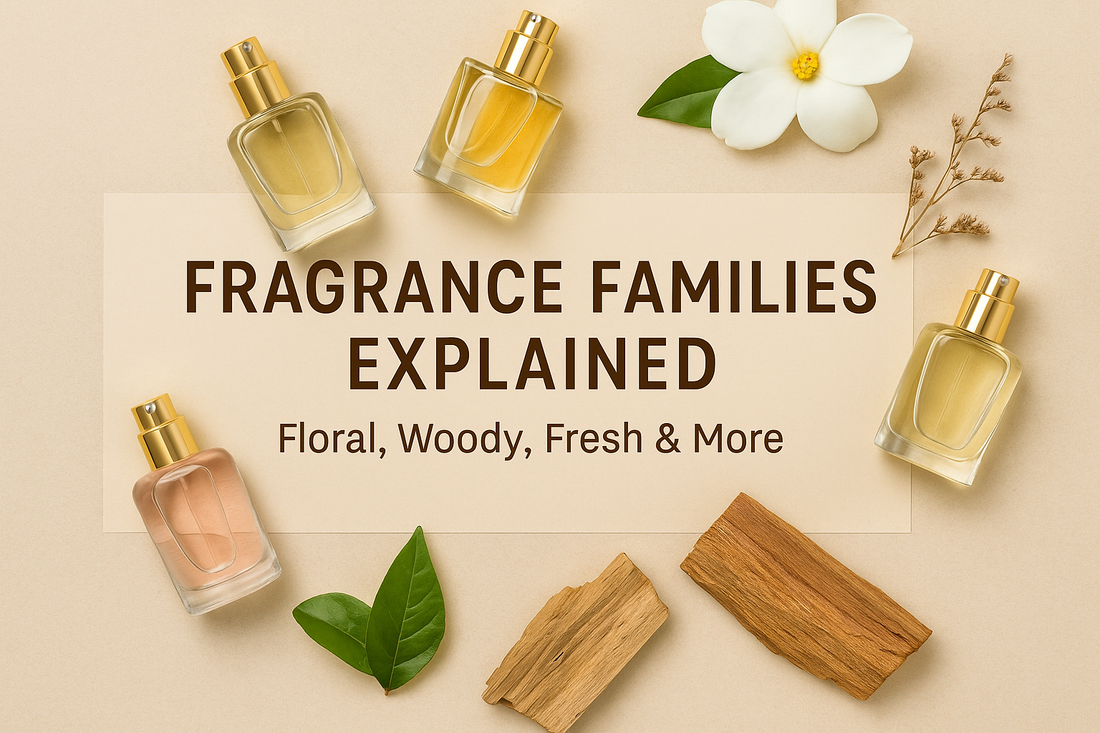
All About Fragrance Families: The Building Blocks of Perfume
Share
Have you ever stood in front of a perfume counter and felt overwhelmed? You are not alone. With numerous bottles, notes, and names, selecting the right fragrance can feel intimidating. But this task can become much easier by understanding fragrance families.
In this guide, we’ll help you understand the world of fragrance families — what they are, why are they important, and how to find the one that is perfect for you.
What Are Fragrance Families?
Fragrance families are divisions that group perfumes as per their major aromatic characteristics — simply speaking, the complete vibe or scent profile.
You may consider them as music genres. Just like rock, jazz, or classical music have different feels, fragrance families help you understand what to expect from a scent before you even use it.
There are four dominant families (with many sub-families under each):
- Floral
- Oriental (also called Amber)
- Woody
- Fresh
Let’s get a detailed understanding about each.
1. Floral – Romantic & Feminine
This is the most popular and commonly used family in the world of fragrances. Floral perfumes are ruled by blooming flowers like rose, jasmine, lily, peony, and more.
Subtypes:
- Single Floral (Soliflore): Based on one flower (e.g., Rose-based)
- Floral Bouquet: A mixture of different flowers
- Fruity Floral: Flowers combined with fruity notes such as peach or berries
-
Vibe: Soft, romantic, often feminine
Ideal for: Date nights, spring and summer wear, everyday elegance
Examples:
- J’adore
- Bloom
2. Oriental (Amber) – Warm & Exotic
Oriental or amber fragrances are rich, spicy, and sensual. They often highlight vanilla, musk, spices, and resins, giving rise to warmth and mystery.
Subtypes:
- Soft Oriental: Powdery notes having mild spices
- Floral Oriental: Blends flowers with oriental magic
- Woody Oriental: Adds a hint of sandalwood or patchouli
-
Vibe: Sensual, bold, mysterious
Perfect for: Evening events, winter, special occasions
Examples:
- Black Opium
- Noir
3. Woody – Earthy & Sophisticated
Woody fragrances remind us of the forest — sandalwood, cedarwood, patchouli, and vetiver. They're often used in masculine fragrances but can also be unisex or elegant based on the blend.
Subtypes:
- Woody Oriental: Mixes warm woods with spicy or sweet notes
- Dry Woods (Leathery): Smoky, almost dusty
- Aromatic Woods: Infused with herbs and lavender
-
Vibe: Established, refined, confident
Ideal for: Office wear, fall/winter, signature scents
Examples:
- Terre
- Bleu
4. Fresh – Clean & Energizing
Fresh fragrances have a feel of fresh air. They usually have citrus, aquatic, green, or herbal notes.
Subtypes:
- Citrus: Lemon, bergamot, grapefruit
- Aquatic: Marine-influenced, ocean breeze aura
- Green: Grass, leaves, herbs — very natural
- Fruity: Non-floral fruits such as apple, melon
-
Vibe: vibrant, youthful, sporty
Perfect for: Summer, workouts, casual wear
Examples:
- Light Blue
- One
Bonus: Gourmand – Edible & Delicious
Though not actually a part of the traditional four families, gourmand scents need to be mentioned. These perfumes are ruled by dessert-like fragrances with top notes being vanilla, chocolate, caramel, coffee, or cotton candy.
Vibe: Sweet, playful, indulgent
Ideal for: Winter, cozy vibes, prominent
Examples:
- Candy
- Thierry Mugler Angel
How to Find Your Favourite Fragrance Family
The best way of finding your favourite fragrance family is by thinking of what you’re attracted to in real life.
- If you love the smell of fresh-cut flowers you can try floral.
- If you are attracted to spice markets or incense you can go for oriental.
- If you like the outdoors or smoky woods you can explore woody.
- If you prefer citrusy colognes or breezy vibes you can try a fresh type.
- Try a few from each family and see how they make you feel because in the end, the best fragrance is the one that you like.
A Fragrance Wheel can also assist you with this. A fragrance wheel is a visual tool used to categorize perfumes based on their scent families and how they are related to each other. It was developed by fragrance expert Michael Edwards to help people get to know and understand different types of perfumes.
Frequently Asked Questions
1. What are fragrance families in perfumes?
Fragrance families are divisions used to group perfumes based on similar or dominant scent traits. They help classify scents into types like floral, woody, oriental, and fresh, this makes it easier to comprehend and select perfumes.
2. Why are fragrance families important when buying a perfume?
If you know your preferred fragrance family it helps with making choices. For instance, if you like warm and spicy scents, oriental or woody families might be suitable for you.
3. How many main fragrance families are there?
There are usually four primary fragrance families:
- Floral
- Oriental
- Woody
-
Fresh
Each of these can be further divided into subfamilies like citrus, aromatic, gourmand, and chypre.
4. What is the floral fragrance family?
This family is ruled by floral notes like rose, jasmine, lily, and peony. It’s the most popular family and often related to feminine, romantic scents.
5. What does the oriental fragrance family smell like?
Oriental fragrances are warm, rich, and exotic. They typically have notes like amber, spices, vanilla, and resins. They’re often ideal for evening wear.
6. How do woody fragrances smell?
Woody perfumes have earthy, warm, and smooth notes such as sandalwood, cedar, vetiver, and patchouli. They are generally used in unisex or masculine fragrances.
7. What is the fresh fragrance family?
Fresh scents are clean, light, and elevating. This family has citrus (like lemon and bergamot), green (like freshly cut grass or leaves), and aquatic (marine or oceanic) scents.
8. Can one perfume belong to more than one fragrance family?
Yes, many modern perfumes are mixtures of more than one family. For example, a perfume can be both floral and oriental (often referred to as “floriental”).
9. What fragrance family is best for daily wear?
Fresh or light floral scents are generally best for everyday use as they’re not very strong and feel clean and breezy.
10. How can I find out which fragrance family suits me best?
You can think about the types of smells you are naturally drawn towards in candles, lotions, or body sprays.
Final Note
An understanding about fragrance families helps you get a deep understanding of the world of perfumery. It helps you understand what you like, find new favorites, and help boost your confidence with your favourite scent.
So next time you’re shopping for a perfume, don’t get confused with so many bottles. Just ask: what family does this scent belong to?
